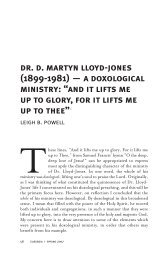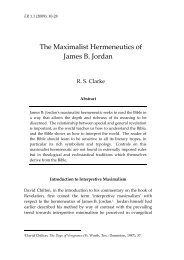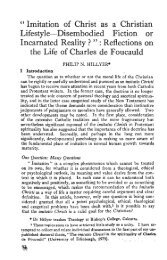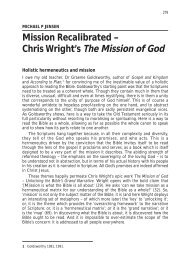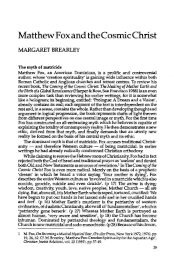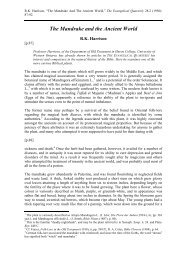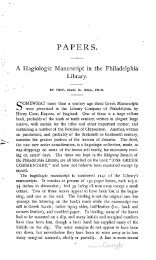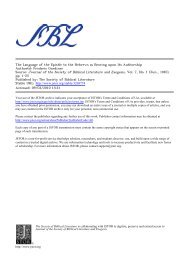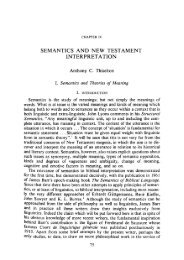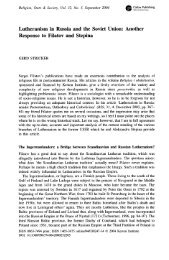Ancient Orient and Old Testament - BiblicalStudies.org.uk
Ancient Orient and Old Testament - BiblicalStudies.org.uk
Ancient Orient and Old Testament - BiblicalStudies.org.uk
You also want an ePaper? Increase the reach of your titles
YUMPU automatically turns print PDFs into web optimized ePapers that Google loves.
K.A. Kitchen, <strong>Ancient</strong> <strong>Orient</strong> <strong>and</strong> <strong>Old</strong> <strong>Testament</strong>. London: Inter-Varsity Press, 1966. Hbk. pp.191.<br />
have difficulties persisted: the interpretation of certain data from the reigns of Ahaz <strong>and</strong><br />
Hezekiah, 68 <strong>and</strong> certain dates linked with the capture <strong>and</strong> fall of Jerusalem in the period 609-587/6<br />
BC. 69 New data <strong>and</strong> close study may well eliminate even these quite limited problems.<br />
[p.77]<br />
One must remember that ancient methods of reckoning were not the same as ours. In the <strong>Ancient</strong><br />
Near East two main kinds of regnal year are attested. By one method, a king reckoned the interval<br />
between his accession <strong>and</strong> the next New Year’s Day as his accession-year (in effect, attributing<br />
that year to his deceased predecessor) <strong>and</strong> began his first regnal year with New Year’s Day. This<br />
system was current in Mesopotamia. By the second method, a king counted the interval between<br />
his accession <strong>and</strong> New Year’s Day as his first regnal year (in effect, attributing that whole year to<br />
his own reign), <strong>and</strong> began his second regnal year on New Year’s Day. This was the Egyptian<br />
method. The official years of a king on the first system are his real total reign; but on the second<br />
system, the official regnal years of a king will always be one higher than his real total (unless he<br />
died exactly at midnight on New Year’s Eve, an unlikely event). Thus, if two kings were exactly<br />
contemporary but used different systems, their regnal years would always show a difference of<br />
one year at any given time. 70 Proper underst<strong>and</strong>ing <strong>and</strong> application of these methods is the main<br />
key to the detailed figures in Kings <strong>and</strong> Chronicles.<br />
(c) Exile <strong>and</strong> Later<br />
The main framework of chronology from 600 BC onwards is on the whole well fixed, 71 <strong>and</strong> the<br />
only biblical question of note is the dispute over the relative order of Ezra <strong>and</strong> Nehemiah. Suffice<br />
it to say here that the biblical order is factually no more objectionable than the often advocated<br />
reverse order. 72<br />
Irwin), 1956, pp. 39-52, <strong>and</strong> in AUSS 1 (1963), pp. 121-138, AUSS 2 (1964), pp. 120-136. The rival scheme of<br />
Albright (BASOR 100 (1945), pp. 16-22; cf. BANE, pp. 208-213 <strong>and</strong> pp. 226-228, notes 20-50) is inferior in<br />
both its methods <strong>and</strong> results (cf. Thiele, Mysterious Numbers.... 1951 ed., pp. 244-267, A Stubborn Faith..., pp.<br />
39-41, <strong>and</strong> AUSS 1 (1963), pp. 132 ff.). The same may be said of V. Pavlovsky <strong>and</strong> E. Vogt, Biblica 45<br />
(1964), 321-347, cf. 348-354, <strong>and</strong> Jepsen in A. Jepsen <strong>and</strong> R. Hanhart, Untersuchungen zur Israelitisch Jüdischen<br />
Chronologie, 1964.<br />
68 See commentary to Table II in my Hittite Hieroglyphs, Aramaeans <strong>and</strong> Hebrew Traditions (forthcoming).<br />
Recent discussions include those of H. Tadmor, Scripta Hierosoymitana VIII (Studies in the Bible), 1961, pp.<br />
232-271; C. Schedl, VT 12 (1962), pp. 88-119; S. H. Horn, AUSS 2 (1964), pp. 40-52; <strong>and</strong> E. R. Thiele, VT<br />
16 (1966), 83-103, 103-7.<br />
69 Recent discussions include: W. F. Albright, BASOR 143 (1956), pp. 28-33; E. R. Thiele, ibid., pp. 22-27; H.<br />
Tadmor, JNES 15 (1956), pp. 226-230; J. P. Hyatt, JBL 75 (1956), pp. 277-284; D. N. Freedman, BA 19<br />
(1956), pp. 50-60; E. Vogt, VTS IV, 1957, pp. 67-96; E. Kutsch, ZAW 71 (1959) pp. 270-274; E. Auerbach,<br />
VT 9 (1959), pp. 113-121; VT 10 (1960), pp. 69-70; VT 11 (1961), pp. 128-136; <strong>and</strong> C. Schedl, ZAW 74<br />
(1962) pp. 209-213.<br />
70 When neighbouring states also begin their calendar years at different seasons (e.g., in spring or autumn),<br />
or when civil <strong>and</strong> calendar years do not coincide (as in New Kingdom Egypt), then further complications<br />
enter into our attempts to unravel <strong>Ancient</strong> Near Eastern chronology, biblical or otherwise.<br />
71 For Mesopotamia, cf. R. A. Parker <strong>and</strong> W. H. Dubberstein, Babylonian Chronology, 626 BC-AD 75, 1956,<br />
giving tables to turn Mesopotamian dates into Julian dates; for Egyptian dates in the Twenty-sixth Dynasty,<br />
cf. R. A. Parker, Mitteilungen des Deutschen Archaologischen Instituts, Abteilung Kairo, 15 (1957), pp. 208-212;<br />
<strong>and</strong> E. Hornung, ZAS 92 (1965), pp. 38-39 (solar eclipse).<br />
72 General survey (reversing order of Ezra <strong>and</strong> Nehemiah) is given by H. H. Rowley, ‘The Chronological<br />
Order of Ezra <strong>and</strong> Nehemiah’ in The Servant of the Lord <strong>and</strong> Other Essays, 1952, pp. 131-159. A modified ‘re-




